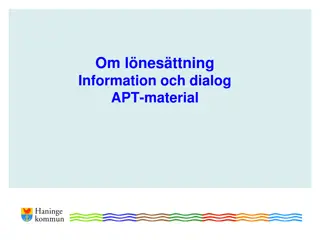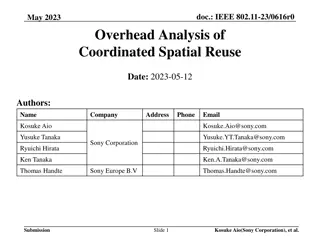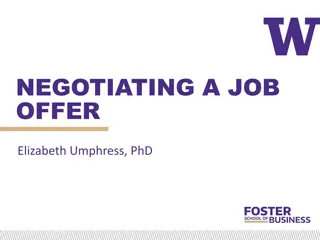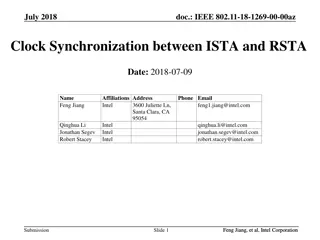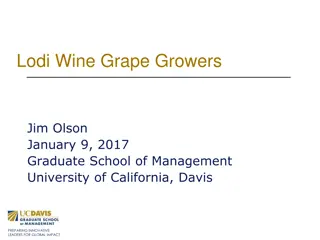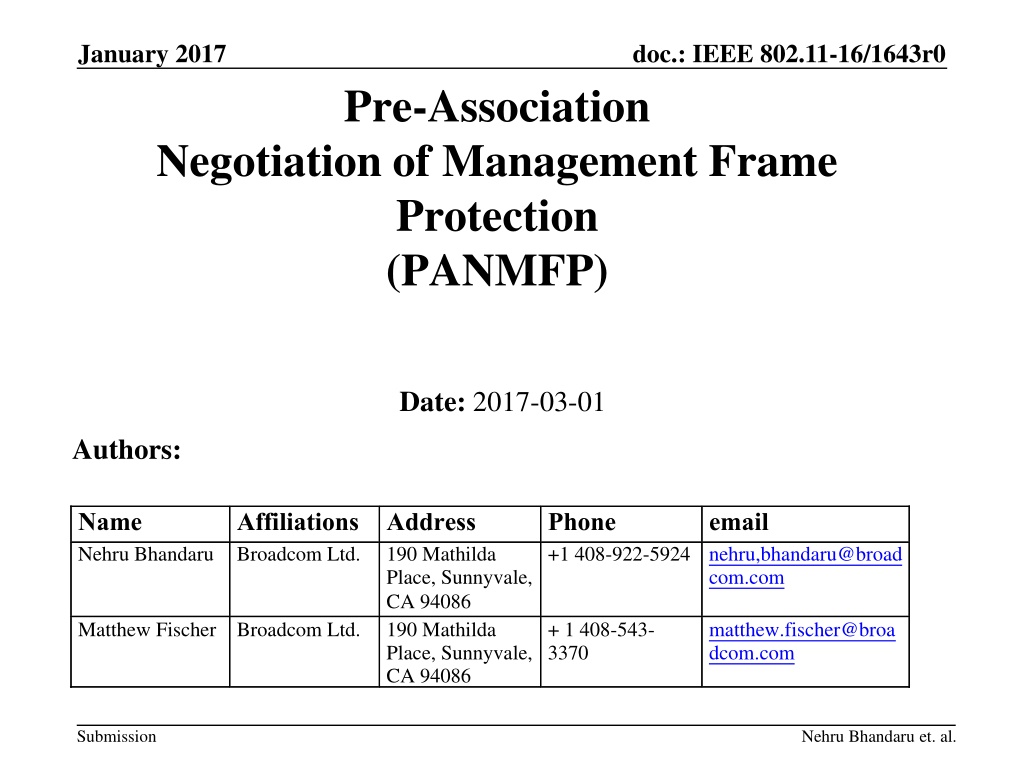
IEEE 802.11-16/1643r0 PANMFP Protocol Overview
Delve into the January 2017 document discussing the IEEE 802.11-16/1643r0 Pre-Association Negotiation of Management Frame Protection (PANMFP) protocol. Uncover the background, introduction, and authentication protocols for enhancing security in FTM and location services. Explore the mechanisms and standards employed for safeguarding management frames pre and post association, utilizing xCMP and AES for protection against physical layer attacks.
Download Presentation

Please find below an Image/Link to download the presentation.
The content on the website is provided AS IS for your information and personal use only. It may not be sold, licensed, or shared on other websites without obtaining consent from the author. If you encounter any issues during the download, it is possible that the publisher has removed the file from their server.
You are allowed to download the files provided on this website for personal or commercial use, subject to the condition that they are used lawfully. All files are the property of their respective owners.
The content on the website is provided AS IS for your information and personal use only. It may not be sold, licensed, or shared on other websites without obtaining consent from the author.
E N D
Presentation Transcript
January 2017 doc.: IEEE 802.11-16/1643r0 Pre-Association Negotiation of Management Frame Protection (PANMFP) Date: 2017-03-01 Authors: Name Nehru Bhandaru Broadcom Ltd. Affiliations Address Phone +1 408-922-5924 nehru,bhandaru@broad com.com email 190 Mathilda Place, Sunnyvale, CA 94086 190 Mathilda Place, Sunnyvale, CA 94086 Matthew Fischer Broadcom Ltd. + 1 408-543- 3370 matthew.fischer@broa dcom.com Submission Nehru Bhandaru et. al.
January 2017 doc.: IEEE 802.11-16/1643r0 Background Motivation for FTM Security Integrity of measurement and location Requires management and control frame protection Location and ranging privacy Management frame protection Earlier Contributions (See references) FTM Security Enhancements (16/1020r0) Security Requirements (16/1256r1) FTM Security in Associated and Un-associated States (16/1498r1) Group interest in more detail Protection in Un-associated state Mechanism allows any management frame to be protected Using standard MFP after key derivation whether associated or not Submission Slide 2 Nehru Bhandaru et. al.
January 2017 doc.: IEEE 802.11-16/1643r0 Introduction We believe xCMP should be leveraged to protect management frames pre and post association Protect FTM/Location Protect additional discovery mechanisms (e.g. Service Discovery) Additional privacy pre-association Possible in Un-associated state with extensions to key negotiation protocol(s) PANMFP protocol is presented here Not discussed in this presentation Control frame protection, but it can leverage MFP Mechanisms to protect against physical layer attacks Standard Management Frame Protection (MFP) i.e. using AES- Submission Slide 3 Nehru Bhandaru et. al.
January 2017 doc.: IEEE 802.11-16/1643r0 PANMFP Authentication Protocol non-AP STA AP Beacon(RSNIE(PANMFP)) Auth(1, PANMFP, PMKID(s), DH-S(FCG, FFE) or SNonce, RSNIE, Wrapped Data) Auth(2, PANMFP, PMKID, DH-A(FCG, FFE) or ANonce, Wrapped Data, MIC) Auth(3, PANMFP, MIC) Submission Slide 4 Nehru Bhandaru et. al.
January 2017 doc.: IEEE 802.11-16/1643r0 PANMFP Authentication Protocol RSN IE advertises PANMFP AKM PANMFP 802.11 authentication protocol establishes a PTK Mutual authentication Includes key confirmation Optional support for PFS Use existing elements - FCG, FFE, Wrapped Data, MIC Management frame protection using the PTK Unicast frame protection only Protect robust action frames and de-authentication frame Submission Slide 5 Nehru Bhandaru et. al.
January 2017 doc.: IEEE 802.11-16/1643r0 PANMFP Authentication Protocol Authentication Frame 1 PMKID(s) identifying possible PMK(s) from initial Security Association to another AP in ESS can use any AKM for initial SA identified in RSN IE Allow for DH or Nonces to derive PTK Optionally allow Wrapped Data - can carry EAP-rp as in FILS Submission Slide 6 Nehru Bhandaru et. al.
January 2017 doc.: IEEE 802.11-16/1643r0 PANMFP Authentication Protocol Authentication Frame 2 PMKID identifying the PMK Optionally allow Wrapped Data - can carry EAP-rp as in FILS MIC protects the frame AP derives PTK before sending the frame DH public values or nonces are integrity protected using PTK (KCK) KCK used with CMAC or HMAC-SHA-xxx where xxx is 384 or 256 as determined by RSNIE Example key derivation(s) PTK without PFS = KDF-Hash-Length(PMK, PANMFP-PTK , SNonce||ANonce||BSSID||STA-Addr) PTK with PFS = KDF-Hash-Length(PMK, PANMFP-PTK , DH-shared-secret||BSSID||STA-Addr) MIC lengths of 16 or 24 octets as in [1] KCK length is per AKM in the RSNIE KEK not used Submission Slide 7 Nehru Bhandaru et. al.
January 2017 doc.: IEEE 802.11-16/1643r0 PANMFP Authentication Protocol Authentication Frame 3 Completes key confirmation with MIC Keys installed on AP after the frame is ACK d Keys installed on non-AP STA after the frame ACK is received Submission Slide 8 Nehru Bhandaru et. al.
January 2017 doc.: IEEE 802.11-16/1643r0 Expected changes to 802.11 Spec AKM selector for PANMFP AKM (Table 9-133) Algorithm Assigned Number for PANMFP PANMFP Key derivation and hierarchy (12.7.1.x) PANMFP Authentication Protocol (12.x) frame generation and processing on STA and AP Frame filtering Robust action frames are class 2 when SA established by PANMFP is present FTM negotiation Advertise secure FTM capabilities (Extended Capabilities IE) Negotiate secure FTM use (FTM parameters) Secure FTM relies on PANMFP and standard MFP FTM Security Considerations Submission Slide 9 Nehru Bhandaru et. al.
January 2017 doc.: IEEE 802.11-16/1643r0 Questions & Discussion Can we use SAE No, since SAE derives PMK only What about FILS Used for initial authentication only Key confirmation part of association Wrapped data can be used to execute EAP-rp protocol to derive PMK What about FBT PMK-r1 can be used as PMK in PANMFP How is PMK distributed No new mechanisms for PMK distribution. Can we work with no PMK Possibly, similar to OWE Changes to 802.11 state machine Not required, but filtering rules change Submission Slide 10 Nehru Bhandaru et. al.
January 2017 doc.: IEEE 802.11-16/1643r0 Questions & Discussion Do we need replay protection for negotiation No, renegotiate with new Nonces or FFEs Can association follow PANMFP authentication and data frame protection using keys derived via PANMFP No, must 802.11 re-authenticate, re-associate and establish an RSN SA that is not from PANMFP Can Authentication happen with Public Keys and Certificates instead of a PMK Yes, but not in the scope of this proposal Can the key be negotiated in two messages No, since the first message may not be protected and needs to be confirmed Submission Slide 11 Nehru Bhandaru et. al.
January 2017 doc.: IEEE 802.11-16/1643r0 Summary FTM/11az needs security FTM frame protection should use standard MFP Presented a pre-association protocol To establish keys to protect FTM and other frames prior to association Independent of FTM Can possibly protect other frames Submission Slide 12 Nehru Bhandaru et. al.
January 2017 doc.: IEEE 802.11-16/1643r0 Straw Poll The 802.11 authentication method described here should be used for negotiating pre-association security (Keys, SA) used to secure FTM Agree: Disagree: Abstain: Submission Slide 13 Nehru Bhandaru et. al.
January 2017 doc.: IEEE 802.11-16/1643r0 References [1] IEEE Std 802.11 REVmc_D8.0, IEEE Standard for Information Technology Telecommunications and information exchange between systems, local and metropolitan area networks Specific requirements, Part 11: Wireless LAN Medium Access Control (MAC) and Physical Layer (PHY) Specifications [2] Proposed 802.11az Functional Requirements , IEEE 802.11-16/424r3 [3] IEEE 802.11-16/1020r0, Q. Wang, et. al., Security Enhancement to FTM , July 2016 [4] IEEE 802.11-16/1256-01-00az, Qi Wang et. al., Functional Requirement for Secure Ranging [5] IEEE 802.11-16/1498-01-00az, Qi Wang et. al., FTM Security in Associated and Un-sssociated States Submission Slide 14 Nehru Bhandaru et. al.

